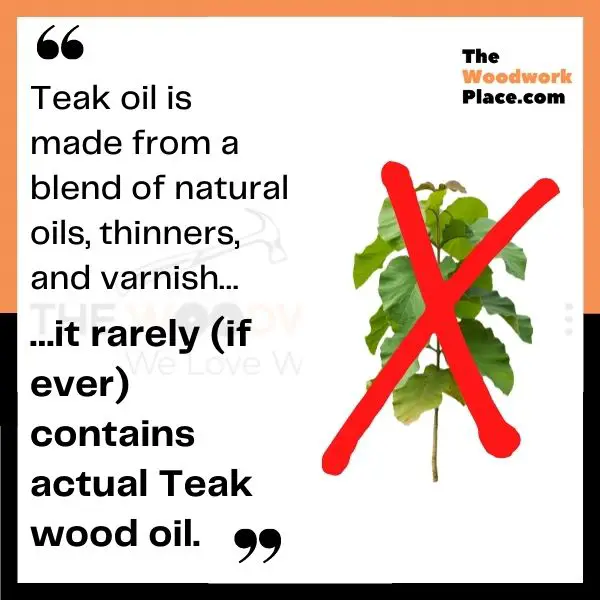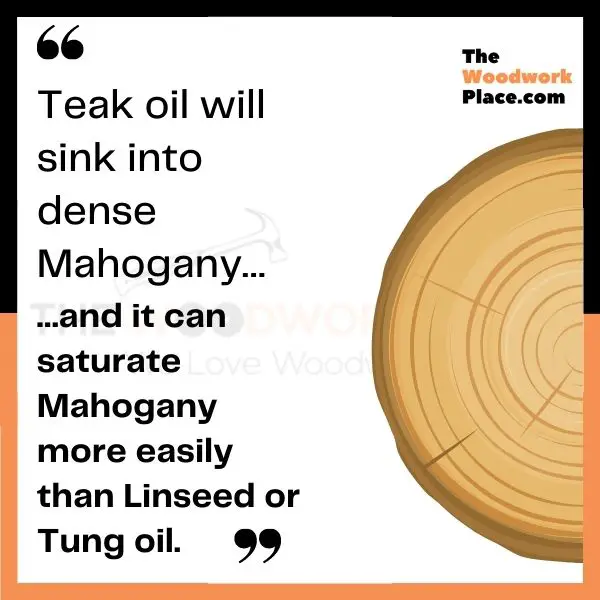Are you considering using Teak oil on your Mahogany masterpiece?
With a wide range of oil finishes to choose from, ask any woodworker their favorite finish, and they’ll happily tell you. Yet, have you ever wondered why Teak oil rarely pops up as anyone’s preferred oil finish?
On the surface, there doesn’t seem to be much to separate Teak oil from its more popular Danish oil counterpart (more on this later in this post). And if that’s the case, then what’s stopping you from finishing Mahogany wood with a Teak oil coat?
Well, to help you decide, in this post you will learn why Teak oil is a better Mahogany wood preservative than Linseed oil or Tung oil. Also, you will find out what really goes into a Teak oil finish (it’s not what you think it is!)

This post may contain affiliate links to products that we receive a commission for (at no additional cost to you). Learn more here.
First Off, What Is Teak Oil Exactly?
If you take a look at the label of any Teak oil container, you’ll find that this finish doesn’t contain any oil from the oily Teak tree.
Teak wood is a very dense tight-grained wood that produces its own natural wood preserving oil. In fact, Teak tree lumber is so naturally oily, that it can often be left untreated.
However, Teak oil doesn’t contain any actual Teak oil. Rather, this finishing product is made up of a mixed bag of natural oils, varnish, UV inhibitors, and mineral spirits.
Sometimes it may contain Linseed oil. Other times it can contain Tung oil. But, one thing Teak oil does not contain is natural Teak tree wood oil.
Related Post: Can You Apply Teak Oil On Maple Wood? (Best Practice Revealed)
So, Why Is It Named Teak Oil?
Marketing and promotional purposes, for the most part.
This blended oil finish was originally designed as an oil for Teak wood… hence its ‘Teak oil’ name. But, other than its name, it bares little resemblance to real natural Teak wood oil.
Instead, Teak oil is more similar to something like Danish oil. That’s because Danish oil, (just like Teak oil), also contains Linseed/Tung oil, varnish and mineral spirits.

OK, Then What’s The Difference Between Linseed Oil And Teak Oil?
The difference between the two is that one is an all natural oil, while the other is a derivative oil.
Linseed oil is extracted from crushed Flaxseed. Even the fast-drying version of Linseed oil, Boiled Linseed oil, is also made from pure Linseed oil. Except this version has drying agents added to it.
Teak oil, however, is made from a hodgepodge of different ingredients – both natural and synthetic. Plus, no two Teak oil products contain the same recipe or ingredient ratios.
In short; Linseed oil is natural, and Teak oil is not.
Related Post: Is Teak Oil Food Safe Enough For A Chopping Block?
And Does A Teak Oil Finish Dry Hard?
Teak oil is a drying oil, so this finish will dry and polymerize (when exposed to air). Which means that a coat of Teak oil will cure and harden into a solid resin.
Related Post: Teak Oil Not Drying? (What You Need To Know)
But, Can You Use Teak Oil On Any Non-Teak Wood?
Well, Teak oil was originally created for Teak wood. But there is nothing in this wood finish that prevents it from being used on any other type of timber.
If that wooden surface can take a coat of Danish oil, then it can easily take a coat of Teak oil too.
Related Post: All About Danish Oil: Advantages and Disadvantages
Having said that, in general, Teak oil isn’t the best option for wood. And there are better wood preserving options out there.
For example, pure Tung oil is better for outdoor applications, because mildew doesn’t grow on this finish. Which is something that can happen to water-damaged coats of Linseed oil (as well as any Linseed oil derivative finishes).

So, Why Bother With Teak Oil At All?
One big advantage to using Teak oil is the fact that it is thinner than other oil finishes. And this works to Teak oils advantage when it comes to Mahogany wood.
You see, very dense lumber, (like Teak wood and Mahogany wood), have tight grain. And this close-grain texture can make it hard for thick oil finishes to soak right down into that surface.
A thinned out oil, such as Teak oil, can sink deep into even the most dense wood grain. Which is why a Teak oil finish can be better at preserving wooden furniture than a pure Linseed/Tung oil finish alone.
Related Post: Is Mahogany Wood Good For Outdoor Furniture?
And Will A Teak Oil Finish Darken Mahogany Wood?
If that Teak oil blend contains a lot of Linseed oil, then yes it can. Pure Linseed oil tends to naturally darken wood—especially when that piece is kept in a low-light environment.
Otherwise, a clear Teak oil product shouldn’t darken a wooden surface anymore than say a Tung oil finish would. Which is to say, not very much.
How Long Will A Teak Oil Finish Last (After Curing)? A few months to a year. Teak oil finishes need to be reapplied every 6-12 months—otherwise they will wear down and fade.
To Wrap Up, Here Are The 3 Key Takeaways From This Post…
1). Teak oil is made from a blend of natural oils, thinners, and varnish. It rarely (if ever) contains actual Teak wood oil.
2). Teak oil will sink into dense Mahogany. And it can saturate Mahogany more easily than Linseed or Tung oil.
3). There isn’t much difference between Danish oil and Teak oil… but always check the label!



